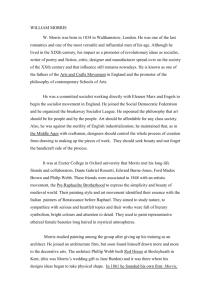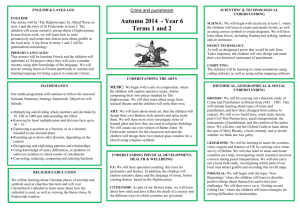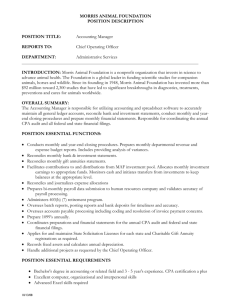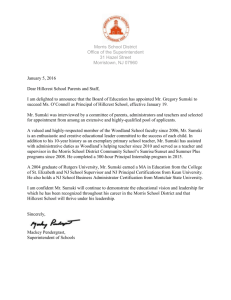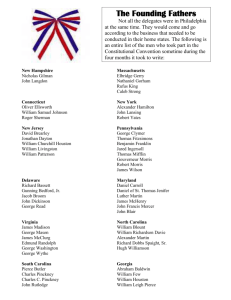Lanercost Priory stop 4 Edward Burne-Jones - Cumbria-study
advertisement
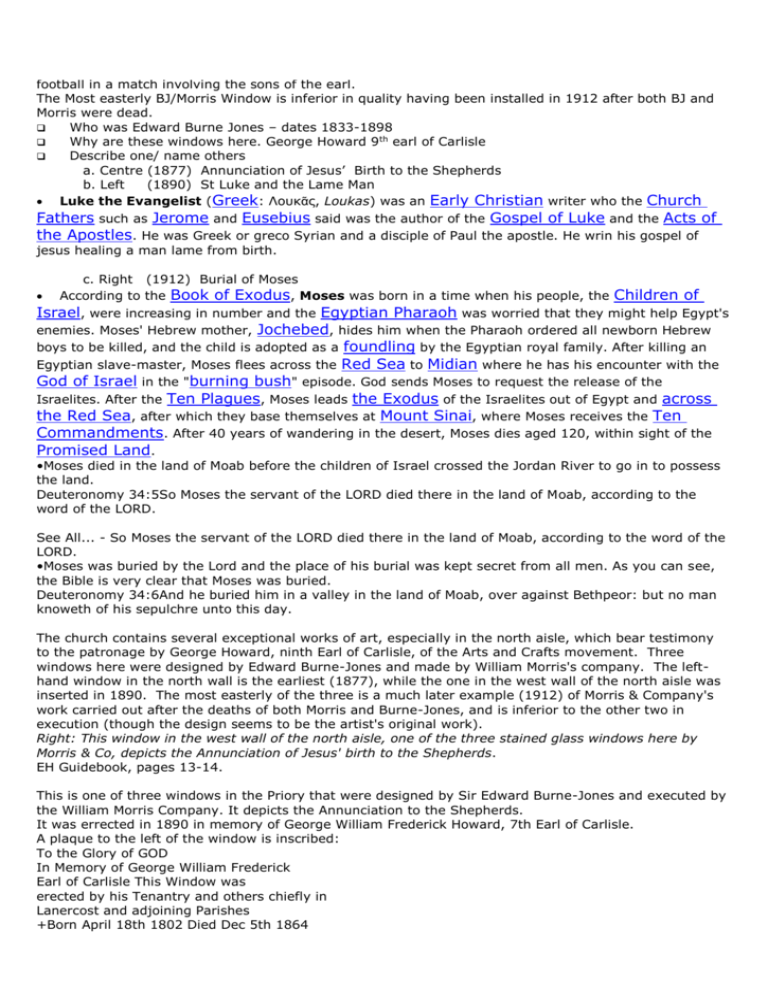
4 Edward Burne-Jones windows. Guide one of the following: The Burn Jones Window in the west wall of the north aisle replaced a window that was destroyed by a football in a match involving the sons of the earl. The Most easterly BJ/Morris Window is inferior in quality having been installed in 1912 after both BJ and Morris were dead. Who was Edward Burne Jones – dates 1833-1898 Why are these windows here. George Howard 9th earl of Carlisle Describe one/ name others a. Centre (1877) Annunciation of Jesus’ Birth to the Shepherds b. Left (1890) St Luke and the Lame Man Luke the Evangelist (Greek: Λουκᾶς, Loukas) was an Early Christian writer who the Church Fathers such as Jerome and Eusebius said was the author of the Gospel of Luke and the Acts of the Apostles. He was Greek or greco Syrian and a disciple of Paul the apostle. He wrin his gospel of jesus healing a man lame from birth. c. Right (1912) Burial of Moses According to the Book of Exodus, Moses was born in a time when his people, the Children of Israel, were increasing in number and the Egyptian Pharaoh was worried that they might help Egypt's enemies. Moses' Hebrew mother, Jochebed, hides him when the Pharaoh ordered all newborn Hebrew boys to be killed, and the child is adopted as a foundling by the Egyptian royal family. After killing an Egyptian slave-master, Moses flees across the Red Sea to Midian where he has his encounter with the God of Israel in the "burning bush" episode. God sends Moses to request the release of the Israelites. After the Ten Plagues, Moses leads the Exodus of the Israelites out of Egypt and across the Red Sea, after which they base themselves at Mount Sinai, where Moses receives the Ten Commandments. After 40 years of wandering in the desert, Moses dies aged 120, within sight of the Promised Land. •Moses died in the land of Moab before the children of Israel crossed the Jordan River to go in to possess the land. Deuteronomy 34:5So Moses the servant of the LORD died there in the land of Moab, according to the word of the LORD. See All... - So Moses the servant of the LORD died there in the land of Moab, according to the word of the LORD. •Moses was buried by the Lord and the place of his burial was kept secret from all men. As you can see, the Bible is very clear that Moses was buried. Deuteronomy 34:6And he buried him in a valley in the land of Moab, over against Bethpeor: but no man knoweth of his sepulchre unto this day. The church contains several exceptional works of art, especially in the north aisle, which bear testimony to the patronage by George Howard, ninth Earl of Carlisle, of the Arts and Crafts movement. Three windows here were designed by Edward Burne-Jones and made by William Morris's company. The lefthand window in the north wall is the earliest (1877), while the one in the west wall of the north aisle was inserted in 1890. The most easterly of the three is a much later example (1912) of Morris & Company's work carried out after the deaths of both Morris and Burne-Jones, and is inferior to the other two in execution (though the design seems to be the artist's original work). Right: This window in the west wall of the north aisle, one of the three stained glass windows here by Morris & Co, depicts the Annunciation of Jesus' birth to the Shepherds. EH Guidebook, pages 13-14. This is one of three windows in the Priory that were designed by Sir Edward Burne-Jones and executed by the William Morris Company. It depicts the Annunciation to the Shepherds. It was errected in 1890 in memory of George William Frederick Howard, 7th Earl of Carlisle. A plaque to the left of the window is inscribed: To the Glory of GOD In Memory of George William Frederick Earl of Carlisle This Window was erected by his Tenantry and others chiefly in Lanercost and adjoining Parishes +Born April 18th 1802 Died Dec 5th 1864 Easter 1866 +The LORD shall be thine Everlasting Light Immediately below it is a second plaque that bears the inscription THE ORIGINAL WINDOW HAVING BEEN INJURED, THE PRESENT WINDOW WAS PLACED IN ITS STEAD BY THE SISTERS OF THE 7TH EARL ad 1890 http://www.lanercostpriory.org.uk/priory/glass_1.html The second of the three windows in the Priory that were designed by Sir Edward Burne-Jones and executed by the William Morris Company. It was installed in 1877 in memory of Dr Robert Brown. The upper panel depicts St Luke writing his account of the nativity. The lower panel depicts the healing of the Lame Man at the Beautiful Gate of the Temple. http://www.lanercostpriory.org.uk/priory/glass_2.html The second of three windows in the Priory that were designed by Sir Edward Burne-Jones and executed by the William Morris Company in 1912 (sixteen years after William Morris's death). It depicts the burial of Moses. It is enscribed: TO THE GLORY OF GOD AND IN LOVING MEMORY OF THE REVEREND ISAAC DODGSON VICAR OF LANERCOST BORN MARCH 22ND 1821 DIED FEB 14TH 1873 AND OF MARGARET HIS WIFE BORN JVNE 6TH 1822 DIES AVG 6TH 1895 THIS WINDOW IS ERECTED BY THEIR THREE SVRVIVNG DAVGTHERS Their is also a memorial to him in the sanctuary. http://www.lanercostpriory.org.uk/priory/glass_3.html Naworth Castle – Library; The overmantel relief of the Battle of Flodden Field, 1880-6, was modelled in gesso by Sir Edgar Boehm, to a design by Burne-Jones, who then modified it before final painting. George Howard commissioned a 21-ft (6.3 metre) painting by Burne-Jones, The Sleep of King Arthur in Avalon, for this room (now at the Luis Ferré Foundation, Puerto Rico). Pevsner, page 546 Burne-Jones in Cumbrian churches, according to Pevsner Staveley (W) – St James Church – In the middle Crucifixion and an effortful Ascension with many angels... - p629 Troutbeck (W) – Jesus Church – Stained glass makes the church. Green is the overall tint, the Life of Christ the subject. All the principal artists were involved: Burne-Jones for the main lights... Another Morris & Co window, of 1898, on the N, this time all red swirling seraphim above, greeny-gold angels below, a youthful Christ parting the clouds between. The design was by Burne-Jones. - page 640 Armathwaite ( C) – Chapel of Christ and St Mary – E window by William Morris & Co, 1926, the L light designed by JH Dearle, the R a Burne-Jones design. - page 114 Brampton – St Martins – All by Morris & Co to Burne-Jones design. .. The windows are wonderful. E, commemorating the Hon. Charles Howard, died 1879, richly coloured and jewel-like. - page 178 Broughton-in-Furness (L) – St Mary Magdalene – IN the old nave, S, Spes by William Morris & Co (designer Burne-Jones) from Redcar, installed here in 1948. page 200 Irton ( C) – St Paul – St Catherine is by William Morris, the others by Burne-Jones. Page 422 Kirkbampton ( C) – St Peter – E triplet by Morris & Co , 1871,... beautiful figure of Christ with flag of St George by Burne-Jones. Page 455 Sir Edward Burne-Jones A pupil of Dante Gabriel Rossetti and a protégé of John Ruskin Edward BurneJones belonged to the second generation of the Pre-Raphaelite Brotherhood, creating a narrative style of romantic symbolism steeped in medieval legend and fused with the influence of the Italian Rennaissance. He became one of the most sought-after painters in Europe. Edward Burne-Jones (1833-1898) and William Morris (1834-1896) met whilst at Oxford taking Holy Orders. Here they gained inspiration from the writings of Ruskin, and decided they wanted to become artists. Ruskin saw the work of Rossetti and the Pre-Raphaelite Brotherhood as 'the dawn of a new era of art', and Burne-Jones went to London to seek out Rossetti. Rossetti had a contract with Powell's Glass Works to design stained glass windows, and he introduced Burne-Jones to them. Burne-Jones worked for them from 1857 until William Morris formed 'The Firm' in 1861. Morris, Marshall, Faulkner & Co, later to become Morris & Co, had as members Dante Gabriel Rossetti, Ford Madox Brown. Philip Webb, Edward Burne-Jones and They created murals, carvings, stained glass, metal work, embroidery and furniture. Their success was mainly due to Morris and Webb's associations with architects, church decoration being their most important activity. When Burne-Jones joined The Firm in 1861, his job as stained glass window designer at Powell's went to his friend Henry Holiday. Burne-Jones died on June 17th 1898. Six days later at the intervention of the Prince of Wales, a memorial service was held at Westminster Abbey, the first time any artist had been so honoured. Church windows in Cumbria designed by Sir Edward Burne-Jones, and made by Morris & Co : Armathwaite Christ & St Mary Brampton St Martin Broughton in Furness St Mary Irton St Paul Lanercost The Priory Kirkbampton St Peter Ponsonby church Staveley St James Troutbeck Jesus Church Other work in Cumbria by Burne-Jones : Lanercost Priory bronze relief Carlisle, Tullie House paintings/drawings Windows by Sir Edward Burne-Jones at Irton church : There are many places where the paintings and drawings of Burne-Jones may be seen. The main collections are The Tate Gallery in London and the Birmingham Museum and Art Gallery. Carlisle Art Gallery at Tullie House has a good selection of works. The William Morris Gallery at Walthamstow in London has a representative selection of tiles, windows, embroidery, paintings and drawings produced by the Morris Company. A comprehensive book on the work of Edward Burne-Jones is 'Burne-Jones' by Martin Harrison and Bill Waters, published by Barrie & Jenkins in 1973. The text is by Bill Waters from Cockermouth, who was formerly assistant curator of Tullie House Museum in Carlisle. The sections on stained glass are by Martin Harrison, an expert in this subject, who has also written the book 'Victorian Stained Glass', published by Barrie and Jenkins, in 1980. A good introduction is 'Edward Burne-Jones' by Ann S Dean, published by Pitkin. A major exhibition of Burne-Jones work took place at New York, Birmingham and Paris. It contained many examples of Burne-Jones work including many picture from private collections. The exhibition catalogue, 'Edward Burne-Jones Victorian Artist-Dreamer' by Stephen Wildman (curator of the Ruskin Library www.lancs.ac.uk/users/ruskinlib/default.htm) and John Christian, both of whom are noted authorities on Burne-Jones, is published (1998) by The Metropolitan Museum of Art, New York and contains 266 illustrations. It is now the most comprehensive book on the work of Edward Burne-Jones. Burne-Jones was born in Birmingham on 28 August 1833, and Birmingham Museum and Art Gallery has a good collection of paintings and drawings by Burne-Jones, and also the 'Holy Grail' tapestries based on his designs. See the Museums's page about Burne-Jones at: www.birmingham.gov.uk/burnejones. Nearby St Paul's Cathedral has some fine windows by Burne-Jones. He died in London on 16 June 1898, and is buried at Rottingdean, Sussex, where he had a country home. After the death of Morris and Burne-Jones, the Company continued under J.H. Dearle and W.H. Knight. Several windows in Cumbria are from this late Morris period - Wigton, Scotby, Cliburn, Plumpton Wall, Eaglesfield, Hensingham, Muncaster, Ulverston St Mary, Allithwaite and Field Broughton. The Morris firm ended with the death of Dearle in 1940. http://www.visitcumbria.com/edward-burne-jones.htm
